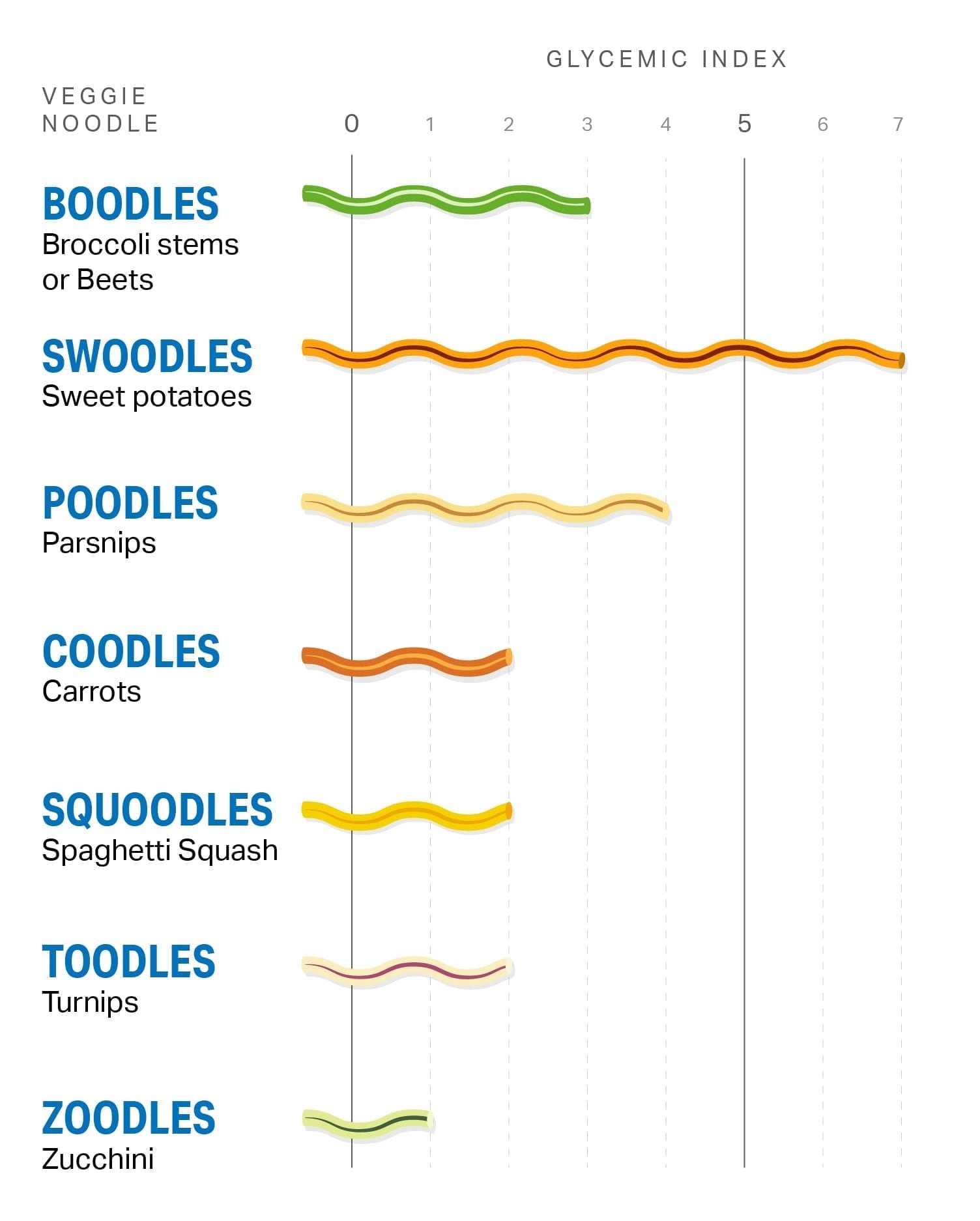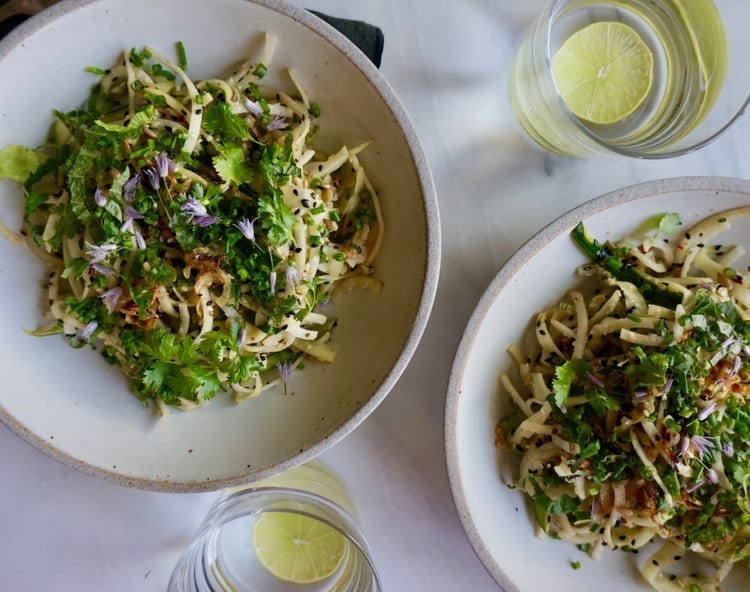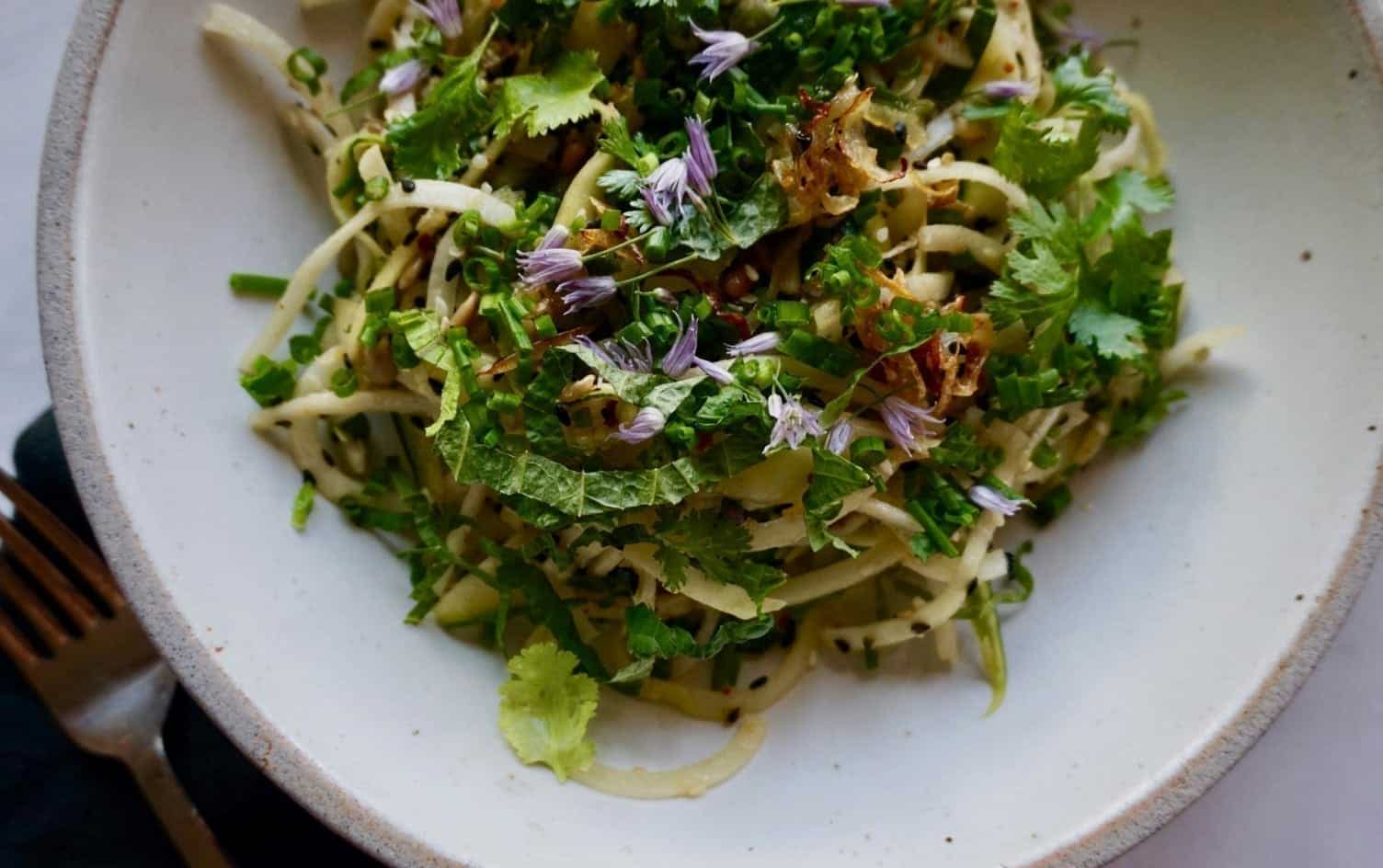Pasta-lovers trying to eat less pasta and more vegetables, rejoice! There are literally oodles of things you can do with veggie noodles!
Veggie “noodles” are veggies — beets, sweet potatoes, butternut squash, zucchini, kohlrabi and more — that have been cut into pasta-like shapes. Typically this happens with a spiralizer that slices the veg into curly, twisty shapes, but you can also slice these veggies with a knife.
Wheat- or grain-based pasta noodles are a major source of carbohydrates and are high on the glycemic index. Since many of us aim to eat lower-glycemic, lower-carbohydrate foods, subbing vegetable noodles is a good alternative. Besides, for all of us, eating more veggies is never a bad thing. Veggie noodles are also gluten- and grain-free for those with dietary intolerances.
To really call a veggie spiral a “noodle” (or a zoodle or a coodle) you’re going to want to choose a vegetable with some starch. Here’s a quick list of the best veggies for noodling, their noodle names and their glycemic load according to Harvard Health. (Compare to whole-grains noodles with a glycemic index of 14.)

The most popular way to make veggie noodles is with a spiralizer. There are several different models at different price points — everything from handheld options to screw spiralizers and expensive countertop options, too. That said, if you aren’t ready to take the spiralizer plunge, you can also use a mandoline, knife or vegetable slicer to create slender strips. Lastly, most well-stocked grocery stores carry pre-packaged coodles, zoodles, boodles and more. Just get yourself to the produce section and take a peek.
Spiralized veggies are quick to cook, but there are a few tips you’ll want to employ for best results.
First, make sure you pat wetter noodles dry before cooking them — zucchini (which is 90% water) and squash are great examples. You’ll want to remove most of this water before cooking, so you don’t simply steam the noodles. All veggie noodles can be boiled, but the cooking time depends on the vegetable. Softer veggies such as zucchini only take 1–2 minutes, whereas sweet potatoes might take 4–5 minutes. For some “noodles,” you may not even choose to cook your veggies — carrots, as an example. Raw vegetables have a lovely texture and exceptional nutrition.
When it comes to sauces, choose less-watery options. If you’re using tomato sauce from a jar, reduce it so it has less water. Cream-based sauces or chunky pestos are great options. Choose richer sauces with lighter vegetables (say, a creamy pesto with zucchini) and perhaps pair more robust sauces with heartier root veggie “noodles” (chunky meat sauce with carrots or broccoli, perhaps).
You could also choose a simple sauce like the one below — honey, lime juice and lots of crunchy seeds make a super raw noodle salad.

Ingredients
- 1/4 cup (60 ml) olive oil
- 2 spring onions or 4 large scallions, thinly sliced and divided
- 1 teaspoon aleppo pepper or crushed red pepper
- Sea salt and pepper, to taste
- 1/4 cup (33g) raw, unsalted sunflower seeds
- 2 tablespoons each black and white sesame seeds
- 2 tablespoons raw hemp seeds
- 1 teaspoon coriander seeds, crushed with a mortar and pestle
- 1 teaspoon cumin seeds, crushed with a mortar and pestle
- 1/4 cup (60 ml) fresh lime juice
- 1 1/2 teaspoons honey
- 1 large zucchini (about 3/4 pounds (340g)), spiralized using a medium blade
- 1 medium kohlrabi (about 3/4 pounds (340g)), spiralized using a medium blade
- 1 cup (20g) fresh herbs (mint, chives, shiso), chopped finely
- 1/4 cup cilantro leaves with tender stems
Directions
Heat 2 tablespoons oil in a small saucepan over medium heat. Cook half of the onions or scallions and the aleppo pepper, stirring occasionally, until golden brown and crisp, 4–5 minutes. With a slotted spoon, transfer chiles and scallions to paper towels; season with salt and pepper, to taste.
Add sunflower, sesame, hemp, coriander and cumin seeds to saucepan and cook over medium heat, stirring, until seeds are lightly golden and spices are fragrant, about 1 minute. Transfer to a large bowl and whisk in lime juice, honey and remaining olive oil; season with salt and pepper, to taste. Add zucchini, kohlrabi, cilantro and remaining scallions. Toss to coat, season with salt, and top with fried chiles and scallions and any remaining fresh herbs. Serve immediately.
Serves: 4 | Serving Size: 1 1/2 cups
Nutrition (Per Serving): Calories: 266; Total Fat: 19g; Saturated Fat: 2g; Cholesterol: 0mg; Sodium: 235mg; Carbohydrate: 20g; Sugar: 11g; Protein: 7g




